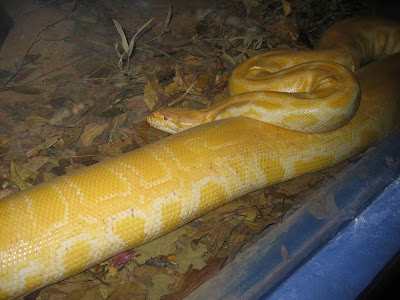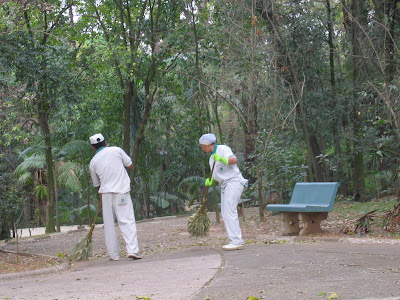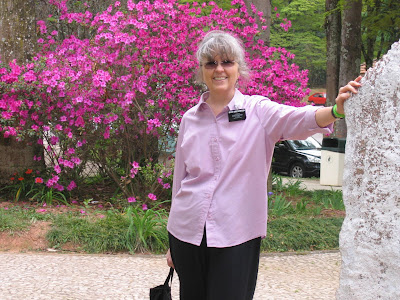This is the old administration building of the Butantan Instituto which is a Brazilian biomedical research center affiliated with the São Paulo State Secretary of Health. It is located near the campus of the University of São Paulo.

This promanade of plaques tells the story of this place. The Institute was founded by a Brazilian physician and biomedical scientist named Vital Brazil in 1901, modeled after the Pasteur Institute system in France. This means that they combine medical research and a learning environment giving students an opportunity to develope medical break-throughs. It is hoped that the learning and research will result in the discovery of serums and vaccines that will provide funds for the continuation of the Institute. President and Sister woodward are the couple in the photo.
 This center is internationally renowned for its research on venomous animals. It maintains one of largest collections of serpents in the world, comprising about 54,000 specimens, and it is also a state-supported producer of vaccines against many infectious diseases, such as rabies, hepatitis, botulism, tetanus, diphtheria, pertussis and tuberculosis. They also develope antivenoms against the bites of snakes, lizards, bees, scorpions and spiders. We took this photo through the glass and as you can see the body of this golden boa is about 10 inches in diameter. He was huge!
This center is internationally renowned for its research on venomous animals. It maintains one of largest collections of serpents in the world, comprising about 54,000 specimens, and it is also a state-supported producer of vaccines against many infectious diseases, such as rabies, hepatitis, botulism, tetanus, diphtheria, pertussis and tuberculosis. They also develope antivenoms against the bites of snakes, lizards, bees, scorpions and spiders. We took this photo through the glass and as you can see the body of this golden boa is about 10 inches in diameter. He was huge! When we walked by the cage of this iguana he came to glass and apperared to be as curious about us as we were about him.
When we walked by the cage of this iguana he came to glass and apperared to be as curious about us as we were about him. Those long dangling rope-like things hanging from this palm tree are a kind of parasite that is attracted to this type of palm. By the way, there are lots of snakes in those pits you see.
Those long dangling rope-like things hanging from this palm tree are a kind of parasite that is attracted to this type of palm. By the way, there are lots of snakes in those pits you see. These delicate little red flowers are well protected on this thorny hedge. No one was climbing over this barrier. It enclosed a small grassy area around one of the buildings at the Institute here at Butanta.
These delicate little red flowers are well protected on this thorny hedge. No one was climbing over this barrier. It enclosed a small grassy area around one of the buildings at the Institute here at Butanta. These workers are using brooms fashioned out huge dead palm leaves. In this area, this was a great examlpe of a renewable resourse. And they were very effective in cleaning debris from the cobblestones.
These workers are using brooms fashioned out huge dead palm leaves. In this area, this was a great examlpe of a renewable resourse. And they were very effective in cleaning debris from the cobblestones.
A Brazilian granite monument to the founders of the medical research and "serpentario" here. They have produced more anti-venom vaccines here than in any other place in the world. Jerry wanted to get o picture of this beautiful flowering shrub. But we couldn't find anyone who knew what it is called. Well as Lowell Thomas used to say, "So long for now". (Only those who are little older will remember who he is. He was a newscaster in the golden days of radio.)
Jerry wanted to get o picture of this beautiful flowering shrub. But we couldn't find anyone who knew what it is called. Well as Lowell Thomas used to say, "So long for now". (Only those who are little older will remember who he is. He was a newscaster in the golden days of radio.)










1 comment:
This is one of the few place you have visited where I have been. It is really so interesting.
D.
Post a Comment